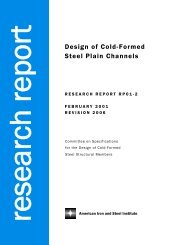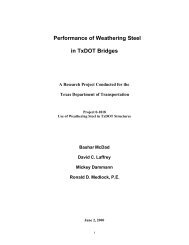Environmental Life Cycle Assessment of Southern Yellow Pine ...
Environmental Life Cycle Assessment of Southern Yellow Pine ...
Environmental Life Cycle Assessment of Southern Yellow Pine ...
Create successful ePaper yourself
Turn your PDF publications into a flip-book with our unique Google optimized e-Paper software.
EXECUTIVE SUMMARY<br />
1.3 Scope <br />
1.3.1 Utility Pole System <br />
This study assessed the use <strong>of</strong> one million distribution poles, including production, installation, <br />
upkeep, and disposal <strong>of</strong> the poles over a 40-‐year period in the Southeastern US. It is assumed that <br />
poles are uniformly distributed across the region, falling under the purview <strong>of</strong> the <strong>Southern</strong> Electrical <br />
Reliability Council (SERC); this region represents most <strong>of</strong> the electrical distribution system in the <br />
Southeastern US. <br />
The pole height and class used in the utility pole system were chosen to be representative <strong>of</strong> a <br />
competitive pole specification. Steel poles are not typically competitive at present with the smaller <br />
Grade C wood poles and do not represent a realistic option for utilities. On the other hand, Class 2 <br />
steel poles are economically competitive with Grade B wood poles and are more likely to be <br />
considered by a utility interested in alternatives to wood. <br />
In terms <strong>of</strong> design criteria, pole height is based mostly on desired clearance from surroundings. Most <br />
wood distribution poles in operation in this region are estimated to be between 35 and 50 feet tall. 7<br />
SCS selected a representative pole <strong>of</strong> each type <strong>of</strong> material for use in this study: <br />
<br />
<br />
Wood poles made from <strong>Southern</strong> yellow pine, grown in the Southeastern US, and treated <br />
with chromated copper arsenic (CCA). <br />
Steel pole: galvanized steel produced using North American hot rolled steel coil. <br />
1.3.1.1 Average Service <strong>Life</strong>times <br />
In this study, the average service lifetime was estimated for each material type; this average lifetime <br />
was used to calculate annual average failure rates, determining the number <strong>of</strong> poles requiring <br />
replacement in each year <strong>of</strong> the study time horizon. These annual average failure rates were <br />
assumed to include replacements due to pole failure, including: catastrophic failure due to weather <br />
and other causes; failure due to corrosion or decay; and replacement due to defective materials. The <br />
average service lifetimes used in the study are described in Sections 1.3.1.1.1 and 1.3.1.1.2. <br />
The replacement <strong>of</strong> poles for reasons other than failure (such as removal due to changes in right-‐<strong>of</strong>-way)<br />
was excluded from the assessment due to a lack <strong>of</strong> data. This bias does not significantly affect <br />
the results <strong>of</strong> the study, as pole failure is the dominant cause <strong>of</strong> pole replacements. <br />
1.3.1.1.1 Galvanized Steel Utility Poles <br />
While galvanized steel utility poles have not been used for a long enough period to determine <br />
average service lifetimes directly, research into similar steel structures, and known corrosion rates <br />
for galvanized steel, were used to estimate the average service lifetime. <br />
7 Shaban, A.O. Power Pole Research. Cal Poly San Luis Obispo, Electrical Engineering. 1/14/02. <br />
April 2013 | ©SCS Global Services <br />
ES-‐ 4

















